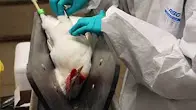Kan høns immuniseres med en aerosol i kombination med vaccinering? Undersøgelse af en ikke-invasiv metode for produktion af antistoffer (afsluttet)
En stor andel af alle forsøgsdyr på verdensplan anvendes til produktion frem for til forsøg: Polyklonale antistoffer er en milliardindustri, hvor immunforsvaret fra mus, rotter, kaniner, geder og andre pattedyr anvendes til at fremstille serum, der kan benyttes til f.eks. diagnosticering af sygdomme. Dyrene injiceres flere gange med f.eks. sygdomsrelevante proteiner sammen med en adjuvans (en opløsning, der forstærker immunsvaret), hvorefter blodprøver bliver opsamlet og antistofferne isoleres.
Disse polyklonale antistoffer udfylder en væsentlig rolle i moderne medicin og medicinsk forskning og er til stor gavn for samfundet. Produktionsprocessen kan dog forbedres i forhold til dyrevelfærd. Hvis antiserum fremstilles i høns behøver man ikke tage blodprøver. Et hønseæg er sprængfyldt med antistoffer, da ægget er evolutionært tilpasset til at beskytte potentielt afkom ved at drage fordel af hønens immunsystem. Ved at isolere antistoffer fra æg kan blodprøvetagning dermed elimineres fra antistofproduktion (og et æg giver langt flere antistoffer end en blodprøve fra f.eks. en kanin). Det eneste invasive indgreb, der er tilbage, er de injektioner med lokalirriterende adjuvans, som anvendes. Vi vil undersøge, hvorvidt disse indgreb kan elimineres, dvs. om fremstilling af polyklonale antistoffer kan gøres til en fuldstændigt ikke-invasiv proces, hvis den gennemføres i høns.
Høns – der lægger de æg, vi spiser – vaccineres rutinemæssigt mod en række sygdomme. Vacciner mod luftvejssygdomme gives ofte som en aerosol, hønsene inhalerer. Den svækkede virus, som udgør vaccinen, kan stadig komme ind i hønens krop gennem luftvejenes slimhinder. Der kommer den i kontakt med immunforsvarets celler, der hurtigt opbygger en immunitet over for den pågældende virus.
Vi ønsker at anvende denne proces ved at knytte proteinet til disse viruspartikler. Ved at få proteinerne til at følge virussen ind i hønens krop, håber vi på at kunne slå to fluer med ét smæk: at vaccinere en høne samtidig med at den immuniseres mod et protein. Antistoffer mod proteinet kan derefter isoleres fra hønens æg i en proces, der i sin helhed ikke påfører kyllingen mere ubehag end de rutinemæssige vaccinationer af vores produktionshøner gør.
Projektstatus november 2017
Vores projektvision var at udvikle og demonstrere en metode til at producere antistoffer i høns uden brug af invasive metoder. Ved at anvende høns i stedet for de almindeligt anvendte pattedyrsmodeller – f.eks. kaniner, mus og rotter – kunne vi undgå behovet for at udtage blodprøver i store mængder og i stedet udvinde antistoffer fra ubefrugtede æg.
Derudover bliver høns rutinemæssigt vaccineret mod luftvejssygdomme – specifikt infektiøs bronkitisvirus – ved hjælp af en inhalerbar aerosol med inaktiverede viruspartikler. Hvis vi i stedet for at injicere vores immunogen – den målstruktur, vi ønsker at rejse antistoffer imod – kunne koble det til de inaktiverede viruspartikler, ville vi kunne immunisere dyrene samtidig med, at de gennemgår deres lovpligtige vaccinationer.
Dette ville eliminere den sidste tilbageværende invasive procedure. På grund af de store mængder antistoffer, der kan udvindes fra ét æg, har den beskrevne tilgang potentiale til at reducere brugen af forsøgsdyr. At fjerne behovet for at injicere immunogener og tage blodprøver udgør en væsentlig forbedring af procedurerne. Lidelse kunne fjernes helt: Der ville ikke være behov for nålestik, ingen behov for stressende fastholdelse, ingen risiko for blodmangel og ingen anvendelse af inflammationsfremkaldende adjuvanser.
Globalt anvendes et betydeligt antal forsøgsdyr til antistofproduktion, og til trods for store fremskridt inden for antistofbaserede metoder, vil vi ikke kunne erstatte brugen af dyr fuldstændigt i den nærmeste fremtid. Derfor kan forbedring af procedurer og reduktion i antallet af nødvendige dyr til antistofproduktion få stor betydning i mange år frem.
Støtten fra Det Danske 3R-Center har gjort det muligt for os at udvikle alle de tekniske procedurer, der kræves for at etablere dette proof-of-concept. De kommercielt tilgængelige hønsevacciner er dog af så ringe kvalitet, at vi på nuværende tidspunkt ikke har kunnet demonstrere metoden i høns. Vi har derfor valgt at udskyde forsøg på høns, da chancerne for succes på nuværende tidspunkt er for lave; dette ville blot udgøre unødvendig brug af forsøgsdyr – noget vi er imod.
Fremadrettet vil vi undersøge mulighederne for at formidle de metoder, vi har udviklet, og vi vil fortsat søge efter muligheder for at skaffe en bedre modelvaccine, der kan gøre det muligt at demonstrere vores idé i sin helhed.
Articles
- Ingen publikation (negative resultater)

